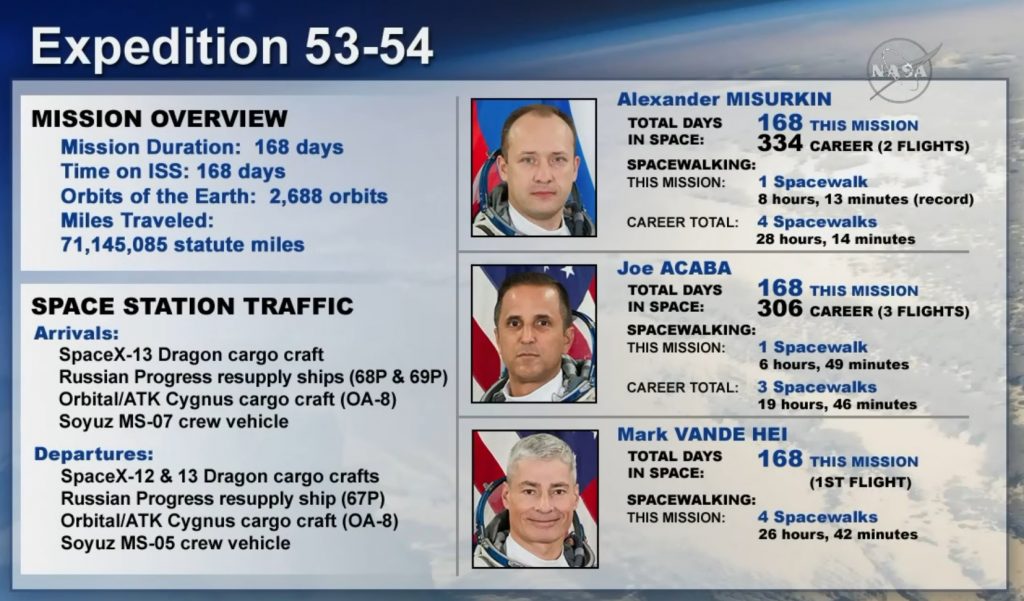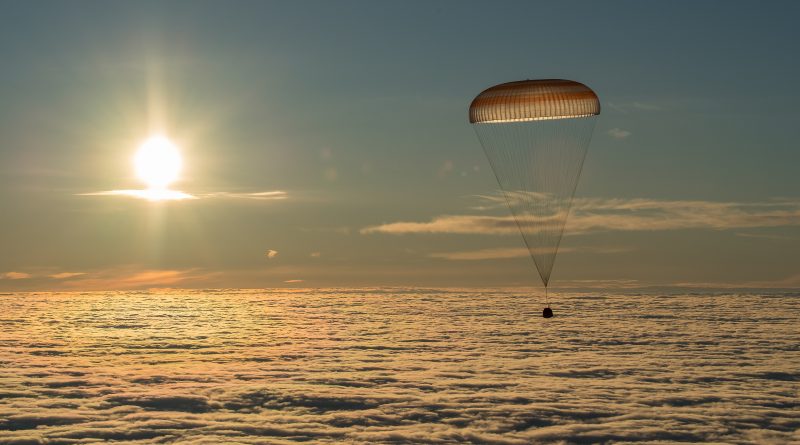Soyuz Parachutes to Safe Landing on Snow-Covered Kazakh Steppe with U.S.-Russian Crew Trio
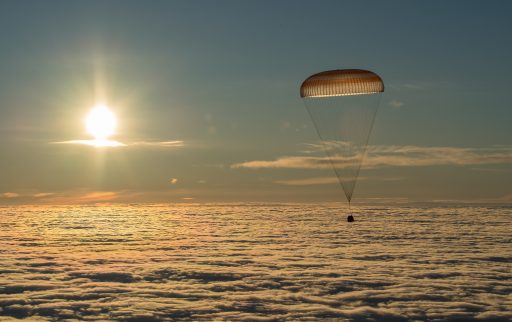
A veteran Cosmonaut and two NASA Astronauts parachuted into the sunrise on Wednesday aboard their Soyuz MS-06 spacecraft after a half-year mission to the International Space Station, touching down on the snow-covered steppe of Kazakhstan after circling the Earth 2,688 times and covering 114.5 million Kilometers. Returning to Terra Firma via a rocket-cushioned touchdown aboard their spacecraft, crew members Aleksandr Misurkin, Mark Vande Hei and Joe Acaba appeared in good spirits as they were helped from the cramped quarters of the Soyuz capsule to grow their land legs back after a 168-day space flight.
Beginning their overnight homecoming, the departing Soyuz trio floated aboard their spacecraft and closed its hatch at 19:58 UTC on Tuesday to set in motion the final preparations for the spring-loaded undocking of the seven-metric ton spacecraft at 23:08 UTC.
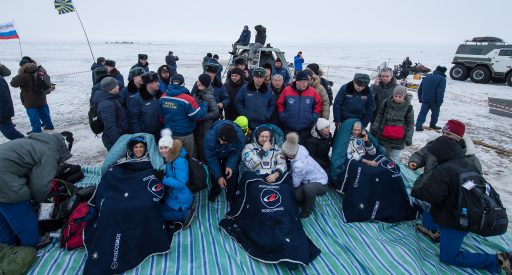
Soyuz MS-06 departed the vicinity of its home in space for the last 24 weeks by firing its own thrusters in order to open a gap before the point of no return – a four-and-a-half minute rocket-powered braking maneuver that placed the Soyuz on a downward arc intercepting the discernible atmosphere over the Middle East, en-route to the craft’s landing site in South-Central Kazakhstan.
Slowing from 7.6 Kilometers per second to a complete stop in just over twenty minutes, the crew endured G-forces of up to five times their body weight followed by a roller coaster ride as Soyuz ejected its parachute at a speed of almost 800 Kilometers per hour.
The big finale of their journey came at 2:31 UTC when Soyuz blasted its soft landing engines and touched down in a remote stretch of the Kazakh steppe to mark the conclusion of the 135th Soyuz mission. A recovery team of over 200 then descended on the landing site and all three crew members were extracted from the space capsule and appeared in good health, enjoying the morning sun after landing just 27 minutes after sunrise.
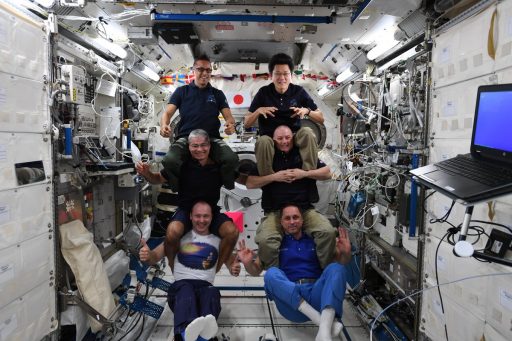
Second-time Soyuz flier Misurkin, army-engineer-turned-astronaut Vande Hei and educator-astronaut Acaba lifted off from the Baikonur Cosmodrome back on September 12, 2017 on a six-hour express flight to the International Space Station to support Expeditions 53 and 54 – two busy science and outfitting increments that saw them work on 300 scientific studies, support five visiting vehicle arrivals and conduct six spacewalks.
Research was the primary focus of the Expedition 53/54 crew on the U.S. Segment that doubled its science contingent in the second half of 2017 as the USOS crew size was increased from three to four as the Russians decided to cut cost by reducing its permanent crew to two for the time being until the Nauka laboratory module can be launched. With an additional pair of hands and only marginal increase of maintenance requirements, the U.S. Segment essentially added one crew member whose time could be fully dedicated to science operations.
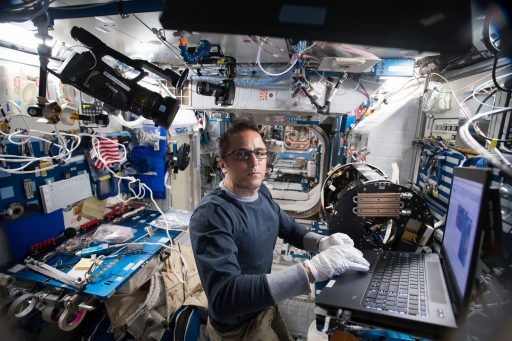
The doubling of available research time was evident in a new record of over 100 crew hours of research conducted in one week whereas the previous target was keeping a steady research time of 40 hours per week. All in all, Expedition 53/54 supported 297 active investigations and brought the total number of different scientific studies carried out aboard ISS to over 2,400 from 98 countries – highlighting the Station’s role as a cutting-edge laboratory for research across all branches of science.
Day-to-day research activities for the crew included maintenance on the station’s scientific facilities, conducting research in physics, chemistry and microbiology while also participating in a plethora of human research studies as subjects themselves, using the half-year missions to the Space Station to explore the effects prolonged exposure to the space environment has on human physiology.
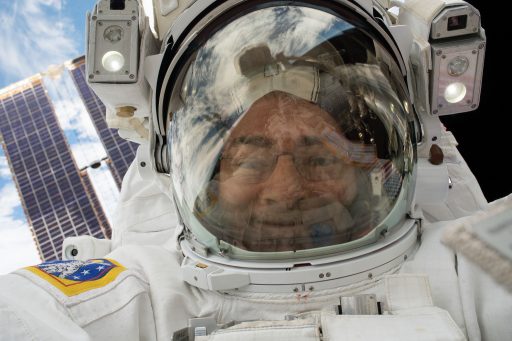
To that end, the returning Soyuz trio was also set for research immediately after landing – looking at their immediate response to gravity to assess whether crews landing at distant destinations will be able to deal with tasks required of them shortly after landing and what countermeasures could be implemented to ease the transition back into a gravity environment.
In addition to a very busy science schedule, the Expedition 53/54 crew supported six spacewalks – five on the U.S. side to swap out both grappling hands of the Station’s Canadarm2 to keep the critical robotic asset in operational condition to capture spacecraft, move equipment and conduct external maintenance while the sole Russian EVA by Misurkin and Anton Shkaplerov revamped the Russian high-gain communications system to be able to communicate through the country’s Luch data relay satellite system.
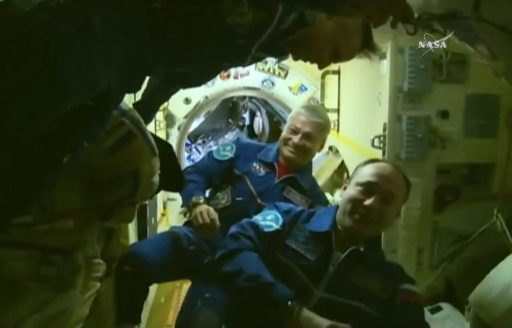
Gearing up for an eventful overnight return, the three departing crew members spent the last two weeks with final preparations – packing their Soyuz with return cargo and testing its various systems while also polishing up their procedural knowledge for nominal and contingency descent scenarios. Outgoing ISS commander Aleksandr Misurkin handed command of the Station over to Anton Shkaplerov on Monday to lead the crew into Expedition 55 that officially started at the moment Soyuz MS-06 departed the orbiting complex.
With their landing events occurring in the overnight hours (UTC), the crew had a fairly quiet day on Tuesday to rest up before pressing into the final cargo loading operations and powering up the Soyuz spacecraft for voice checks through Russian ground stations followed by an update to the descent profile based on the latest trajectory calculations.
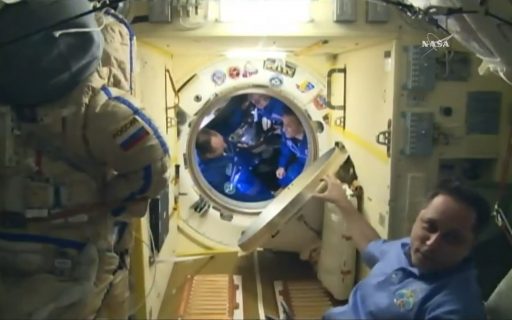
After a last joint dinner in space, the six Expedition 54 crew members split in two groups with the departing crew saying their farewells before crossing the hatchway into their Soyuz MS-06 spacecraft – sealing themselves off at 19:58 UTC when closing the Orbital Module’s hatch. The closure of the ISS-side hatch on the Poisk module cleared the way for the typical hour-long leak check that verified both hatches were holding pressure.
Leak checks provided nominal results and Soyuz MS-06 was switched to autonomous power as interfaces within the docking mechanism were demated and the hooks of the Poisk module opened up so that the spacecraft was only held by its own hooks.
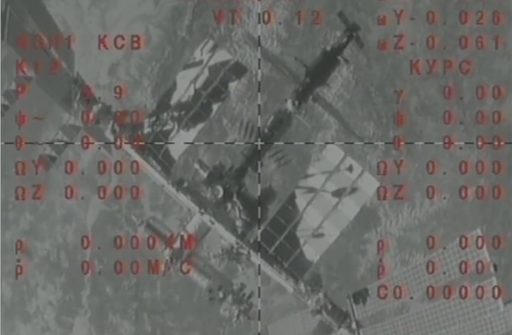
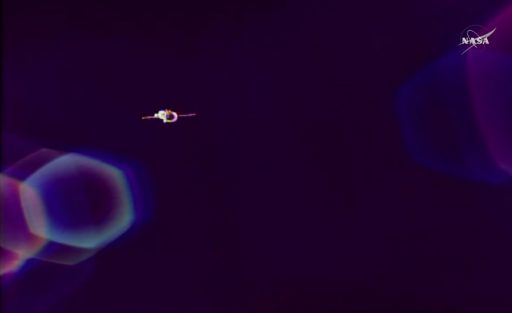
Donning their Sokol Launch and Entry Suits, the three crew members took their places in the Entry Module – Misurkin entered the Commander’s seat in the center, gearing up for his first return as Soyuz Commander, Mark Vande Hei entered the co-pilot position to the left and Joe Acaba strapped himself into the right-hand seat to provide support to the two others when needed.
Soyuz powered up its docking mechanism at the five-minute mark to separation and the Space Station entered a Fine Attitude Hold to avoid thruster firings while Soyuz was going through its demating sequence. Upon reception of the Undocking Command at 23:07:00 UTC, Soyuz began driving open its hooks and pushed off ISS exactly 90 seconds later with four loaded spring assemblies to create an initial opening rate of 0.1 meter per second in order to open the initial gap.
Soyuz re-enabled its thrusters after drifting away passively for two minutes, firing up its DPO thrusters on an initial eight-second, 0.56m/s departure maneuver to accelerate along the radial vector connecting ISS and deep space. The craft then completed a swift re-orientation ahead of an 1.5-meter-per-second burn along the velocity vector to set up the typical departure path without the need for re-orienting the Space Station. Speeding up its opening rate, Soyuz quickly left the immediate vicinity of ISS and the crew settled down for a two-and-a-half-hour free flight during which Soyuz flew to a distance of 12 Kilometers.
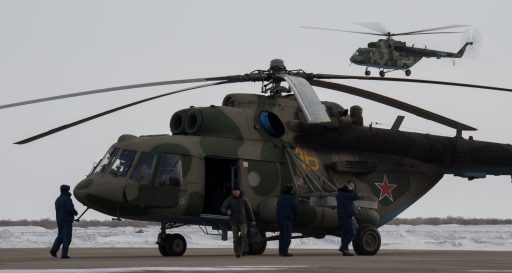
While the Soyuz trio enjoyed their last orbits around Earth, a Search and Rescue Team with over 200 members mobilized in Kazakhstan, still in the dark of night as landing was set to occur just one hour after first light.
Called up for Wednesday’s Soyuz landing were four fixed-wing aircraft acting as airborne command centers and radio relay points along a 500-Kilometer stretch of the craft’s ground track, 12 Mi-8 helicopters dispatched to the primary landing site, the ballistic site and a point in between and 16 ground vehicles including ATVs to brave the cold of winter and position recovery teams beneath the craft’s trek from the Baikonur Cosmodrome to the prime landing location.
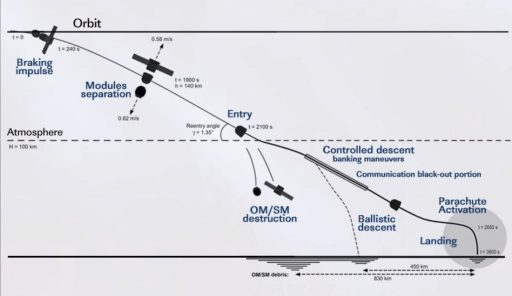
Entering a tail-first orientation, Soyuz MS-06 – flying under the call sign Altair – fired up its SKD main propulsion system at 1:38:39 UTC to slam on the brakes with 300-Kilogram-force of thrust to transition from a stable orbit at 400 Kilometers onto a sub-orbital arc hitting the atmosphere at a precisely calculated location to make it to the landing site. The four-minute and 39-second retrograde engine burn was successful in slowing the Soyuz by 128 meters per second – enough to drop it out of orbit.
Over the next half hour, Soyuz crossed the Atlantic Ocean one last time before flying over Africa, accelerating again to a peak speed of 7.62 Kilometers per second when hitting the atmosphere. A series of pyrotechnics fired at 2:05:50 UTC when Soyuz split in three parts while crossing the Red Sea at an altitude of 140 Kilometers – sending the disposable Service and Orbital Modules toward a fiery demise while the Entry Module fired up its Hydrogen Peroxide-fueled thrusters to enter the correct posture for re-entry.
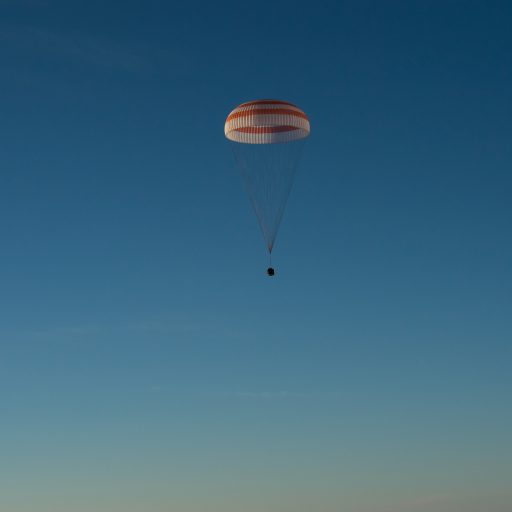
The 2.24 by 2.17-meter Entry Module with the three crewmen inside hit the atmosphere at 2:08:40 UTC when dipping below 100 Kilometers over Northern Iraq. Soyuz was programmed to hold a pre-determined orientation for the first 89 seconds of re-entry to allow air resistance to build up to a decelerating force, triggering the start of the active guidance phase of the descent that used a series of bank maneuvers to bleed off energy while Soyuz also rolled to modify lift in order to control its downrange travel distance and fly out a slight entry point overshoot.
Communications with the crew ceased as Soyuz went through the plasma phase, its heat shield enduring temperatures of 1,600°C and slowly burning away to create a protective layer of colder gas between the spacecraft and the extremely hot shockwave layer in front of it. Soyuz emerged from the plasma when passing through 34 Kilometers in altitude, pulling in excess of 4Gs as it rapidly slowed from 2.1 Kilometers per second in the dense atmosphere.
Slowed to 216 meters by atmospheric friction, Soyuz blew its parachute cover at 2:17:05 UTC and ejected two Pilot Chutes at an altitude of 10.7 Kilometers to pull out the larger Drogue Chute – creating one of the most dynamic descent events for the crew as Soyuz gyrated wildly under the drogue before stabilizing and decelerating to a speed of 80 meters per second.
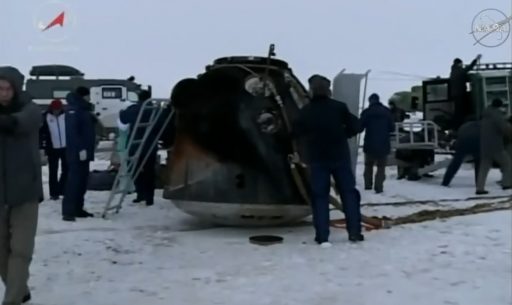
Soyuz deployed its main chute 7.5 Kilometers in altitude to enter a vertical descent toward its landing spot, calmly swaying in the morning sun as the landing program kicked in at 5.5 Kilometers in altitude to take the Soyuz through the last preparatory steps for the big finale. Long-range visuals from the recovery helicopters above the clouds showed Soyuz venting leftover Hydrogen Peroxide from its tanks and drop its heat shield to expose the craft’s altimeter and the soft landing engines. Visible for the crew, Soyuz equalized its cabin pressure, dropped the blackened window covers and moved up be crew seats to absorb some of the shock at landing.
All landing preparations were complete as Soyuz descended below 2,000 meters and recovery helicopters entered racetrack pattern around the descending vehicle while ground teams already raced to the projected landing spot. Moments before touchdown, Soyuz blasted its soft landing engines to cushion its impact before coming to rest upright in around ten centimeters of snow.
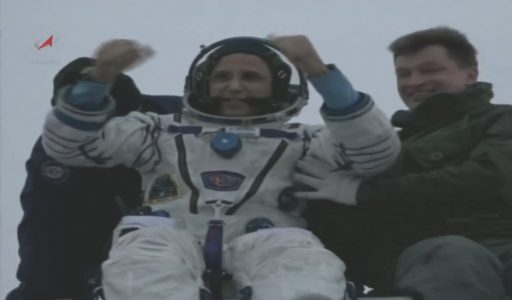
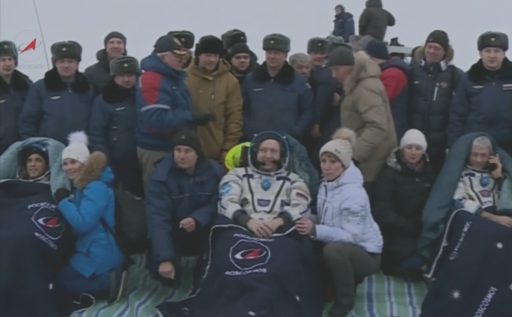
Soyuz landed at 2:31 UTC in the primary landing zone located 147 Kilometers south-east of the remote town of Zhezkazgan, capping a mission of 168 days, 5 hours and 14 minutes.
Search and Rescue personnel reached the landed spacecraft within a few minutes and established radio contact with the crew before opening up the Entry Module’s hatch to begin extracting the three crewmen. Greeted by temperatures around -2°C, the Soyuz trio was welcomed by a typical winter morning when the hatch swung open.
All three crew members appeared in excellent physical condition as they were helped out of the Soyuz and placed in reclining chairs, looking back at nearly half year in space. Soyuz Commander Misurkin extended his record to 334 days spent off the planet on two long-duration ISS missions; Mark Vande Hei closed out his first space mission for 168 days in orbit including nearly 27 hours of spacewalking time; and Joe Acaba now stands at 306 days in space accumulated on a Shuttle mission and two long-duration stints on ISS.
The three crew members were expected to spend less than two hours at the landing site – undergoing medical checks, including the Field Test, and changing into more comfortable clothes before flying to the staging city of Zhezkazgan for a welcoming ceremony. From there, Misurkin will head back to Moscow for post-flight operations while Vande Hei and Acaba are set for almost a full day of traveling to head back to the Johnson Space Center.
ISS is now in the capable hands of Anton Shkaplerov, Scott Tingle and Norishige Kanai for the next three and a half weeks as their Expedition 55 crew mates Oleg Artemyev, Drew Feustel and Ricky Arnold work toward a March 21st liftoff aboard their Soyuz MS-08 spacecraft, set for arrival at ISS two days after launch.
